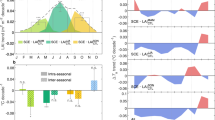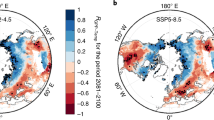Abstract
Global temperature is increasing, especially over northern lands (>50° N), owing to positive feedbacks1. As this increase is most pronounced in winter, temperature seasonality (ST)—conventionally defined as the difference between summer and winter temperatures—is diminishing over time2, a phenomenon that is analogous to its equatorward decline at an annual scale. The initiation, termination and performance of vegetation photosynthetic activity are tied to threshold temperatures3. Trends in the timing of these thresholds and cumulative temperatures above them may alter vegetation productivity, or modify vegetation seasonality (SV), over time. The relationship between ST and SV is critically examined here with newly improved ground and satellite data sets. The observed diminishment of ST and SV is equivalent to 4° and 7° (5° and 6°) latitudinal shift equatorward during the past 30 years in the Arctic (boreal) region. Analysis of simulations from 17 state-of-the-art climate models4 indicates an additional STdiminishment equivalent to a 20° equatorward shift could occur this century. How SV will change in response to such large projected ST declines and the impact this will have on ecosystem services5 are not well understood. Hence the need for continued monitoring6 of northern lands as their seasonal temperature profiles evolve to resemble thosefurther south.
This is a preview of subscription content, access via your institution
Access options
Subscribe to this journal
Receive 12 print issues and online access
$209.00 per year
only $17.42 per issue
Buy this article
- Purchase on Springer Link
- Instant access to full article PDF
Prices may be subject to local taxes which are calculated during checkout




Similar content being viewed by others
References
Serreze, M. C. & Barry, R. G. Processes and impacts of Arctic amplification: A research synthesis. Glob. Planet. Change 77, 85–96 (2011).
Mann, M. E. & Park, J. Greenhouse warming and changes in the seasonal cycle of temperature: Model versus observations. Geophys. Res. Lett. 23, 1111–1114 (1996).
Myneni, R. B., Keeling, C. D., Tucker, C. J., Asrar, G. & Nemani, R. R. Increased plant growth in the northern high latitudes from 1981 to 1991. Nature 386, 698–702 (1997).
Taylor, K. E., Stouffer, R. J. & Meehl, G. A. An overview of CMIP5 and the experiment design. Bull. Am. Meteorol. Soc. 93, 485–498 (2012).
Chapin, F. S. et al. in Ecosystems and Human Well-being: Current State and Trends 717–743 (Island Press, 2005).
Post, E. et al. Ecological dynamics across the arctic associated with recent climate change. Science 325, 1355–1358 (2009).
Hays, J. D., Imbrie, J. & Shackleton, N. J. Variations in the Earth’s orbit: Pacemaker of the ice ages. Science 194, 1121–1132 (1976).
Bhatt, U. S. et al. Circumpolar arctic tundra vegetation change is linked to sea ice decline. Earth Interact. 14, 1–20 (2010).
Zhou, L. et al. Variations in northern vegetation activity inferred from satellite data of vegetation index during 1981 to 1999. J. Geophys. Res. 106, 20069–20083 (2001).
Beck, P. S. A. & Goetz, S. J. Satellite observations of high northern latitude vegetation productivity changes between 1982 and 2008: Ecological variability and regional differences. Environ. Res. Lett. 6, 045501 (2011).
Forbes, B. C., Macias-Fauria, M. & Zetterberg, P. Russian Arctic warming and ‘greening’ are closely tracked by tundra shrub willows. Glob. Change Biol. 16, 1542–1554 (2010).
Macias-Fauria, M., Forbes, B. C., Zetterberg, P. & Kumpula, T. Eurasian Arctic greening reveals teleconnections and the potential for structurally novel ecosystems. Nature Clim. Change 2, 613–618 (2012).
Walker, M. D. et al. Plant community responses to experimental warming across the tundra biome. Proc. Natl Acad. Sci. USA 103, 1342–1346 (2006).
Myers-Smith, I. H. et al. Shrub expansion in tundra ecosystems: Dynamics, impacts and research priorities. Environ. Res. Lett. 6, 045509 (2011).
Callaghan, T. V., Tweedie, C. E. & Webber, P. J. Multi-decadal changes in tundra environments and ecosystems: The International Polar Year-Back to the Future Project (IPY-BTF). Ambio 40, 555–557 (2011).
Peng, C. et al. A drought-induced pervasive increase in tree mortality across Canada’s boreal forests. Nature Clim. Change 1, 467–471 (2011).
Bokhorst, S. F., Bjerke, J. W., Tømmervik, H., Callaghan, T. V. & Phoenix, G. K. Winter warming events damage sub-Arctic vegetation: Consistent evidence from an experimental manipulation and a natural event. J. Ecol. 97, 1408–1415 (2009).
Soja, A. J. et al. Climate-induced boreal forest change: Predictions versus current observations. Glob. Planet. Change 56, 274–296 (2007).
Smith, L. C., Sheng, Y., MacDonald, G. M. & Hinzman, L. D. Disappearing Arctic Lakes. Science 308, 1429–1429 (2005).
Smol, J. P. & Douglas, M. S. V. Crossing the final ecological threshold in high Arctic ponds. Proc. Natl Acad. Sci. USA 104, 12395–12397 (2007).
Callaghan, T. V., Christensen, T. R. & Jantze, E. J. Plant and vegetation dynamics on Disko Island, west Greenland: snapshots separated by over 40 years. Ambio 40, 624–637 (2011).
Klein, D. R. & Shulski, M. Lichen recovery following heavy grazing by reindeer delayed by climate warming. Ambio 38, 11–16 (2009).
Bulygina, O. N., Groisman, P. Y., Razuvaev, V. N. & Korshunova, N. N. Changes in snow cover characteristics over Northern Eurasia since 1966. Environ. Res. Lett. 6, 045204 (2011).
Euskirchen, E. S., McGuire, A. D. & Chapin, F. S. Energy feedbacks of northern high-latitude ecosystems to the climate system due to reduced snow cover during 20th century warming. Glob. Change Biol. 13, 2425–2438 (2007).
Chapin, F. S. et al. Role of land-surface changes in Arctic summer warming. Science 310, 657–660 (2005).
Sturm, M. et al. Winter biological processes could help convert arctic tundra to shrubland. Bioscience 55, 17–26 (2005).
Toutoubalina, O. V. & Rees, W. G. Remote sensing of industrial impact on Arctic vegetation around Noril’sk, northern Siberia: Preliminary results. Int. J. Remote Sensing 20, 2979–2990 (1999).
Tømmervik, H. et al. Above ground biomass changes in the mountain birch forests and mountain heaths of Finnmarksvidda, northern Norway, in the period 1957–2006. Forest Ecol. Manage. 257, 244–257 (2009).
Olofsson, J., Tømmervik, H. & Callaghan, T. V. Vole and Lemming activity observed from space. Nature Clim. Change 2, 880–883 (2012).
Riahi, K., Grübler, A. & Nakicenovic, N. Scenarios of long-term socio-economic and environmental development under climate stabilization. Technol. For. Soc. Change 74, 887–935 (2007).
Acknowledgements
This work was financially supported by the NASA Earth Science Division. We thank CRU, NSIDC, NASA MODIS Project, CAVM team and the CMIP5 climate modelling groups (listed in Supplementary Table S7) for making their data available. The authors thank U. S. Bhatt, H. E. Epstein, G. R. North, M. K. Raynolds, A. R. Stine, G. Schmidt and D. A. Walker for their comments on various parts of this article.
Author information
Authors and Affiliations
Contributions
The analysis was performed by X.L., R.B.M, Z.Z and J.B. All authors contributed with ideas, writing and discussions.
Corresponding authors
Ethics declarations
Competing interests
The authors declare no competing financial interests.
Supplementary information
Supplementary Information
Supplementary Information (PDF 12980 kb)
Rights and permissions
About this article
Cite this article
Xu, L., Myneni, R., Chapin III, F. et al. Temperature and vegetation seasonality diminishment over northern lands. Nature Clim Change 3, 581–586 (2013). https://doi.org/10.1038/nclimate1836
Received:
Accepted:
Published:
Issue Date:
DOI: https://doi.org/10.1038/nclimate1836
This article is cited by
-
Time lag effect of vegetation response to seasonal precipitation in the Mara River Basin
Ecological Processes (2023)
-
Spatial and temporal patterns of stream nutrient limitation in an Arctic catchment
Hydrobiologia (2023)
-
A decline in atmospheric CO2 levels under negative emissions may enhance carbon retention in the terrestrial biosphere
Communications Earth & Environment (2022)
-
Spatial-temporal dynamics of alpine grassland coverage and its response to climate warming in Mt. Qomolangma Nature Preserve during 2000–2019
Journal of Mountain Science (2022)
-
The need to understand the stability of arctic vegetation during rapid climate change: An assessment of imbalance in the literature
Ambio (2022)



